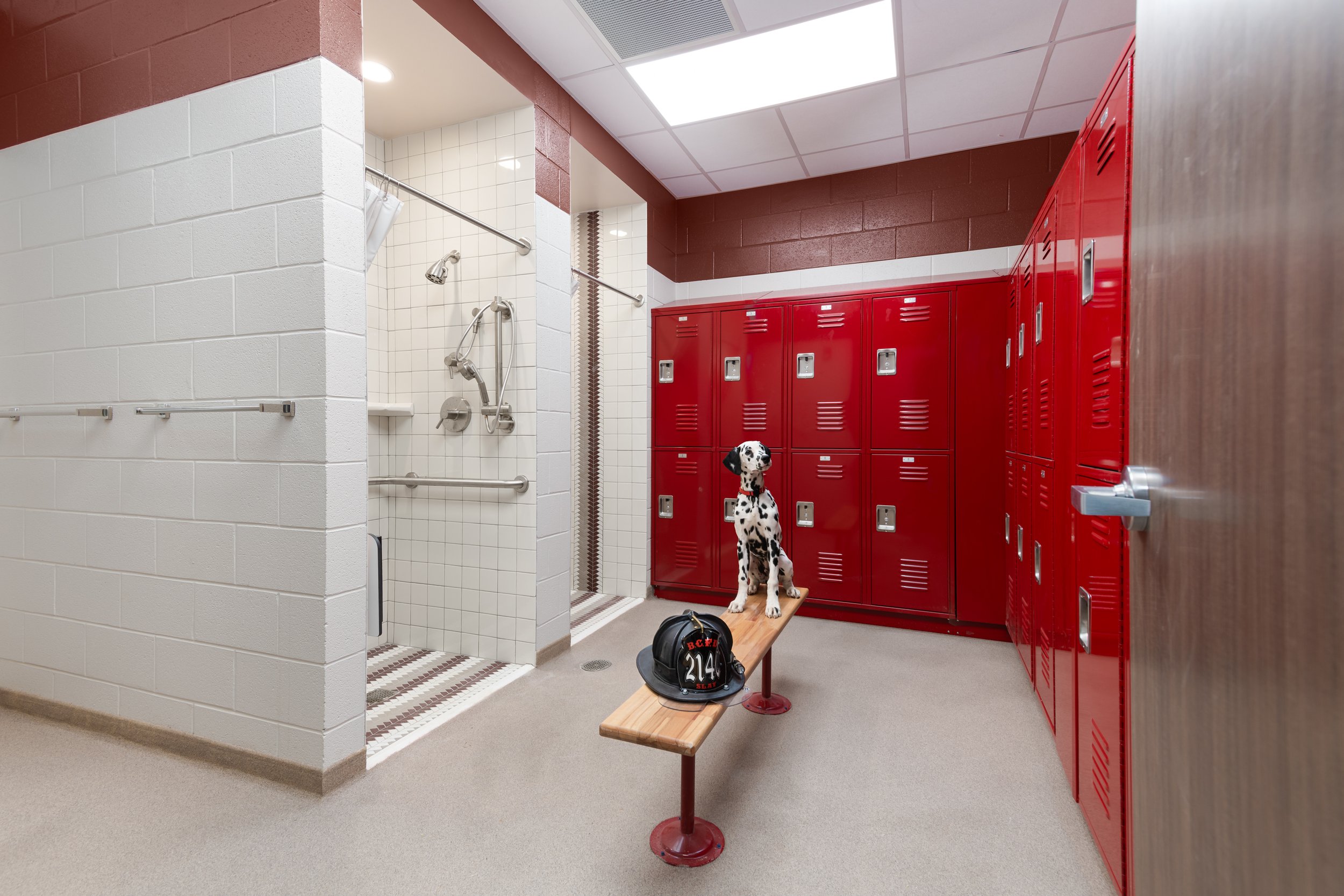Addressing the growing demand for new and updated public safety facilities in and around Middle Tennessee.
As more and more families are moving to Middle Tennessee, it is more important than ever to have sufficient public health and safety agencies in place and ready to support the growing communities they serve. Often, with today’s ever-rising inflation, these facilities are finding a stronger desire to bring multiple municipalities together under one roof. This not only saves on building and construction costs; but also reduces redundancy and wasted space.
Over the years, Kline Swinney Associates (KSA) has designed several public safety agency facilities, such as firehouses, Emergency Medical Services (EMS) buildings, and health departments. But today, we have seen these individual operations become less desirable as the design trends move toward larger, single-footprint facilities that support many entities, rather than just one. In addition, we are also seeing tornado rooms and safety shelters implemented into the new facility designs, which can even be open for the public to use in case of emergency.
A GROWING NEED
It’s no secret that smaller communities, like many in Middle Tennessee, are often lacking sufficient resources and/or funding to fully support their public safety facilities and the first responders that operate out of them. Many fire departments have recently seen budget cuts and lowered staffing numbers, and struggle to maintain their policy compliances, training quotas, equipment upkeep, and even their own firefighter’s safety. (4)
According to the Federal Emergency Management Agency (FEMA), in Tennessee’s neighboring state, North Carolina, there has been a nearly 22% decline in volunteer firefighters in the last two years. The issue is seemingly compounded in smaller communities because those interested in becoming a career or volunteer firefighter tend to gravitate toward larger cities and urban areas for their work. And who can blame them? Big cities have bigger budgets, more facilities, and likely, better pay rates. (5)
The same can be said for EMS paramedics. While the demand for EMS workers has grown dramatically since the pandemic, filling the open positions can be a challenge. According to CNBC, “Funding can also be an issue in some communities, as reimbursements from insurers, patients, and Medicare and Medicaid are outpaced by wage pressures and costs to operate. This is especially common in volunteer programs, funded in large part by community donations and local taxpayer dollars.” (6)
From KSA’s own research into Middle Tennessee’s existing police training facilities, there is a large amount of redundancy in small, once-temporary operating locations scattered throughout the county. Many of these are located close to residential areas, or in too-small, outdated buildings. Even with all the satellite facilities, they still lack in number and space needed to perform even the most basic training operations.
With the ever-expanding need for public safety facilities in our area, Tennessee’s population continues to boom. Davidson County alone has grown 14.5% since 2010 and accounts for 15% of the statewide growth all on its own. Mayor John Cooper tweeted, “that equates to one new resident per hour for the last ten years”. Williamson County saw a 35% increase in the past decade, and Wilson County grew by 29.6%. It’s safe to assume that as these counties continue to see growth, their public safety facilities are fighting to keep up with the demand. (7)
TORNADO / SAFE ROOMS
“Where do you put a million people in a storm-hard facility? Can we build enough structures to house that many people?" -Ken Weidner, Sumner County EMA Office Director (2)
According to The Federal Emergency Management Agency (FEMA), a safe room is a structure specifically designed to provide near-absolute protection in extreme wind events, including tornadoes and hurricanes. It must also be designed and constructed to the guidelines specified in FEMA P-361. They can be installed for private residence use, or within a community space that may serve a larger number of people. (1) There are several specific requirements for space per person and other safety measures that the tornado and/or safe rooms must meet, but all serve generally the same purpose – to keep the user safe from natural disasters outside.
Middle Tennessee has unfortunately seen many severe weather scares and deadly tornadoes within the last few years alone. In fact, the record number of yearly tornadoes was broken in 2021, at 46 tornadoes total for the year. (3) As the weather seemingly gets more unpredictable, the lack of safety shelters offered to the public has government and emergency service leaders concerned. (2) Reportedly, the only safe shelter Putnam County currently has is the county library, which can’t even be opened to the public at night. These statistics prove that Middle Tennesseans are in need of more safe places to turn to in case of emergency, and these options are currently few and far between.
IMPROVEMENTS TO BE MADE
KSA’s own research into existing firehouses, particularly the living/sleeping spaces, showed that many older facilities do not have adequate areas for these activities. Sleeping rooms are often cramped, requiring the users to share rooms. Living and lounge areas are more commonly small corners with a recliner or two, rather than an actual space to stretch out and relax from a long day of work. Even the kitchens tended to have a utilitarian feel, rather than a welcoming environment for the firemen and women to enjoy.
In the public safety facilities that are being constructed today, there are many things that have been modernized to suit the developing field of professionals and adequately support them in their daily activities. These needs are often met with a few small, yet impactful, design decisions.
“ A key consideration is work/life balance, as firefighters often work long and unpredictable hours. Designs that prioritize comfort, safety, and functionality can help mitigate the stress and strain of their jobs. For example, well-designed living quarters with separate bedrooms and bathrooms can provide a more private and restful space for firefighters when they are off duty.”
Sleeping spaces are now more commonly designed for a single user, providing much-needed privacy. Kitchen and living spaces are being designed with a slightly more residential feel while maintaining a professional and modern atmosphere. These spaces also have a larger priority within the facilities than they perhaps used to, so making them central to other operations and spaces within is becoming more common.
Updates in technology are also a crucial part of how new facilities are improving their operations. Never have agencies had to deal with the amount of information available to them today. Taw North from TLC Engineers points out, “from internal sources like radios, traffic cameras, body cameras, 9-1-1 calls, and informational databases, to external sources like media outlets, social media, and the internet, the ability to get the right information in front of critical decision makers has never been more important.” (8) As the list of required technology and devices grows, so must the facility’s ability to maintain and enforce them.
KSA’S CONTRIBUTIONS
After doing countless hours of research and programming to combat all of these issues, KSA is proud to be constructing six new Public Health and Safety Buildings for Rutherford County, Tennessee. These facilities will be a safe space for the surrounding community and better serve the firemen and EMTs working there. Private bedrooms and Men’s and Women’s restrooms, a large kitchen, and a comfortable lounge space are just a few of the ways we have designed these buildings to function better, last longer, and do more for our first responders. The Public Health & Safety Buildings also showcase spacious, pull-through bays for equipment and trucks, ample storage space, and will be multifunctional as the needs for these spaces flexes through the years. We hope these facilities stand out as a symbol to the surrounding communities of how hard our first responders work, and how they deserve to work and live in a space that benefits them.
KSA is also making progress working with the state of Tennessee to design their newest, state-of-the-art facility, The Multi-Agency Law Enforcement Training Academy (MALETA). This academy will be comprised of many facilities, such as cadet housing, firing ranges, an EVOC track, a mock city, offices, classrooms, and more. Truly a labor of love, MALETA will answer many problems that Tennessee law enforcement has battled for years, including a lack of training space, redundancy in design, and smaller satellite facilities spread across the city rather than a central location. As the initial designs for the MALETA campus begin, KSA’s project managers and designers are passionate about making this facility a functional, flexible, usable, and effective training academy for all its potential users for many years to come.







